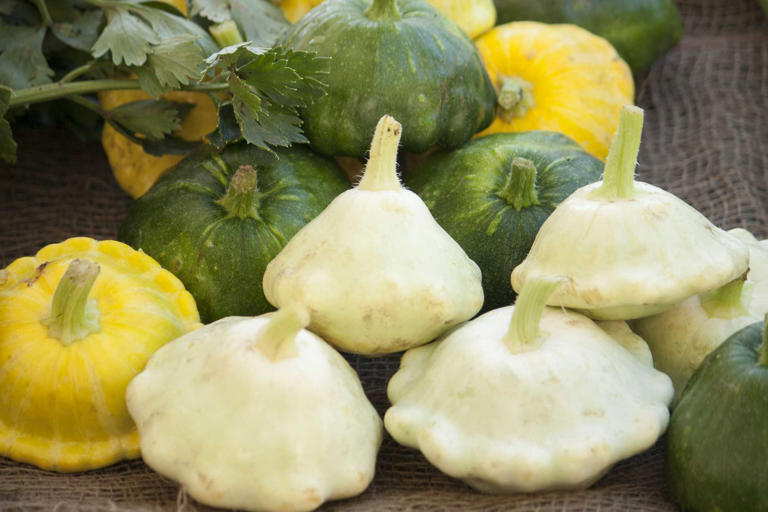Ask A Nutrition Professional: How Do I Prepare Yellow Squash?
















Ask A Nutrition Professional: How Do I Prepare Yellow Squash?
Expert opinion from Cassia D Muller
Bechelor in Nutrition · 2 years of experience · Brazil
Roasted (or Baked) – Cut in half, slice or cut into pieces. Brush with olive oil and season with salt. Bake at 400-degrees for 20-25 minutes or until tender. Throw some other veggies on there to make a delicious roasted vegetable medley. Sautéed – Slice or cut into smaller pieces and sauté in butter over medium-high heat for 10-15 minutes or until tender. Season with salt or seasoning (see ideas below). Grilled – Cut into thick slices or wedges. Brush with vegetable oil and grill for 5 minutes per side or until tender. Season with salt with each turn. Air Fried – Brush with olive oil and sprinkle with salt. Air fry at 375-degrees for 8 minutes, flipping half-way through. Season more after flipping if needed.
Expert opinion from Ledyan Ledyan
Master's degree Medicinal plants and functional food/Bachelor's degree Nutrition · 4 years of experience · Indonesia
Yellow squash is rich in nutrients such as potassium, antioxidants and vitamins that are good for the body. The skin is difficult to peel but there are different methods to get around it. You can steam or boil them and eat them directly. Roasting them inside the oven also makes a great lunch and dinner.
Expert opinion from Mariana Brkic
Yellow squash has to be washed before consuming. There is no need to peel it as its thin skin contains a rich amount of nutrients and is also a good source of fiber. Yellow squash can be eaten cooked or raw. Cooked yellow squash is easier to digest for the body.
| What are people curious about? | |
|---|---|
| Mediterranean diet | Keto diet |
| Diabetic diet | Weight loss |
Disclaimer: This is for information purpose only, and should not be considered as a substitute for medical expertise. These are opinions from an external panel of individual doctors or nutritionists and not to be considered as opinion of Microsoft. Please seek professional help regarding any health conditions or concerns. Medical advice varies across region. Advice from professionals outside your region should be used at your own discretion. Or you should contact a local health professional.
Story by Cassia D Muller, Ledyan Ledyan, Mariana Brkic : Microsoft Health
The anti-ageing benefits of eating protein










The anti-ageing benefits of eating protein
Many people struggle with gaining weight in midlife. I hear it every day in my practice, with patients saying they are eating the same as they ever have and exercising the same amount, but putting on weight.
Our muscle health declines naturally, starting in about our thirties, in a process known as sarcopenia. By the age of fifty, muscle mass decreases at an annual rate of 1-2%. The lost muscle is often replaced by fat.
Added to this natural ageing process, we often become less active than we were in our 20s, more prone to injury and often eating a sub-par diet. This can create the perfect storm, leading to weight gain in middle age and beyond.
The danger of dieting without eating more protein
There are two fundamental principles to maintaining and even building muscle at any age: doing resistance exercises and eating a higher-protein diet. But the problem with the way many of us have traditionally dieted – and what I see a lot of middle-aged women do especially – is eat fewer and fewer calories, but not enough protein.
The result is that their muscle continues to waste away, their metabolism slows and, as a result, losing weight becomes ever harder. The old message that if you want to lose weight, you simply have to eat less and move more is outdated.
If you’re actively trying to lose weight, then yes, you need to be in calorie deficit. But as you cut your calories, you must also up the percentage of protein in your overall intake to protect muscle mass.
We are facing an obesity epidemic – but I believe that current medical advice is failing people and I’m on a mission to change that. I’ve seen up close how people with obesity struggle to lose weight, despite following the outdated advice of just cutting calories, doing more cardio but not paying attention to the amount of protein on the plate.
As we’re finding, increasing protein really is the solution – it helps you to feel full in the short term while improving your body composition in the longer term.
Why we need more protein in midlife and beyond
There are so many benefits of a protein-rich diet, including better balanced blood sugar, increased energy, mental clarity, decreased body fat and reduced cravings. It is crucial for longevity and repairing your body’s tissues.
But most midlife women I see are not eating enough. And I would argue that many people of all ages are not eating enough good-quality protein.
In the UK, Government guidelines for adults is 0.75g protein per kilo of body weight (or if you work in pounds, around 1g per 3 pounds of body weight). But these guidelines – as in the US – were created in the 1970s as a minimum level to prevent deficiencies; it’s not optimal by any stretch of the imagination.
How much protein we really need
My prescription for all adults is at least 1g per 1lb of your ideal body weight per day (or if you work in kilos, about 2.2g per 1kg of ideal body weight).
If you’re trying to lose weight and are on a reduced calorie diet, I suggest up to 1g per 1lb of ideal body weight, or even higher. On top of this, I recommend that the first and last meal of the day should contain at least 30g of protein. There is increasing evidence to show that if you eat 30-50g of protein for breakfast, it sets up your metabolism appropriately, controls hunger and stimulates muscle tissue.
To visualise 30g of protein, this equates to a large chicken breast or fish fillet, or a medium-sized steak or chop, but many more eggs than you might imagine – around five or six. If you’re stuck for inspiration, I send out a https://drgabriellelyon.com/30gs-recipes/ free newsletter with recipes containing 30g of protein each week. These are things that I eat with my family, such as egg and cheese frittatas and air-fried salmon bites.
Steak is better than vegan burgers
I personally eat a lot of red meat – I even have steak for breakfast some days. Red meat has had a bad rap, but a good-quality steak is so much better for your body than ultra-processed plant-based foods like meat-free burgers. Really good-quality meat – by which I mean grass-fed and organic – should be considered a superfood because it delivers so many of the nutrients we need, including iron, zinc, calcium and vitamin B12. It’s also a natural source of creatine, whichmay improve short-term memory.

There have been some reports saying a high-protein diet can lead to kidney dysfunction but several studies now tell us otherwise.
Muscle is the fountain of youth
Muscle should be seen as your body’s armour, protecting you from disease. There are multiple reasons why we develop Alzheimer’s, for example, but new research published in the British Medical Journal has found that if we build up our lean muscle mass it may help prevent it. It is still unclear why - one theory is that it is down to an increase in proteins circulating in the body. Nutrition and exercise programmes can help with recovery from all kinds of disease, including improving cancer outcomes.
We are all interested in living not only longer, but a better quality of life as we age, and the best way to safeguard your independence is to protect your skeletal muscle mass. According to NHS data, around 1 in 3 adults over 65 and half of people over 80 will have at least one fall a year, with the WHO reporting the second most common cause of accidental death is injury from a fall. Increased muscle mass reduces your risk of falling.
This is the long view, but even in the short term you will experience huge benefits from maintaining and building muscle. Increased muscle helps almost every function in the body, from sleep to energy, and even boosts your libido, thanks to increased production of testosterone. Extra muscle also helps you to get or stay lean and manage your weight in midlife and beyond.
It’s no exaggeration to say that I see higher muscle mass as the fountain of youth.
As told to Jessica Salter
Forever Strong: A New, Science-Based Strategy for Ageing Well, by Dr Gabrielle Lyon, Piatkus, is out now. She also has a podcast, The Dr. Gabrielle Lyon Show
New analysis of cancer cells identifies 370 targets for smarter, personalized treatments















New analysis of cancer cells identifies 370 targets for smarter, personalized treatments
Anew, systematic analysis of cancer cells identifies 370 candidate priority drug targets across 27 cancer types, including breast, lung and ovarian cancers.
By looking at multiple layers of functional and genomic information, researchers were able to create an unbiased, panoramic view of what enables cancer cells to grow and survive. They identify new opportunities for cancer therapies in a significant leap towards a new generation of smarter, more effective cancer treatments.
In the most comprehensive study of its kind, researchers from the Wellcome Sanger Institute, Open Targets and their collaborators, pooled together data from 930 cancer cell lines. They then used machine learning methods to find the drug targets that show the most promise for developing new treatments, and the patients who would most benefit from such treatments. This involved assessing the occurrence of these targets in actual patient tumors and linking them to specific biological markers and genetic and molecular features found in the tumors.
The findings, published today (11 January) in Cancer Cell, not only bring researchers one step closer to producing a full Cancer Dependency Map1 of every vulnerability in every type of cancer, but help guide focused efforts to accelerate the development of targeted cancer treatments.
There are many types of cancer that currently lack effective treatments, such as liver and ovarian cancers. Chemotherapy and radiotherapy are effective treatments, but unable to distinguish normal cells from cancerous ones, so can cause damage throughout the entire body with harsh side effects, such as extreme fatigue, nausea and hair loss.
New precision drugs based on the exact genetic mutations that drive the cancer are needed to help the millions of patients diagnosed with some form of cancer each year, responsible for one in six deaths worldwide2. However, drug development has a 90 per cent failure rate3, making it both costly and inefficient.
With over 20,000 potential anti-cancer targets in the genome, determining which are suitable to target for specific types of cancers and patients is a significant challenge.
In this new study, researchers from the Wellcome Sanger Institute and their collaborators set out to narrow down potential drug targets. By analyzing data available from the Cancer Dependency Map project, which involved CRISPR technology4 to disrupt every gene inside 930 human cancer lines one at a time, they were able to produce the most comprehensive view of potential new cancer targets to date.
The researchers first identified weaknesses within different cancer types – so-called genetic dependencies, meaning which genes, proteins or cellular processes that cancer cells rely on to survive – that could be harnessed to make new therapies. They then linked those weaknesses to clinical markers to identify patients in which those therapies would be most effective. Finally, they explored how dependency-marker pairs fit into known networks of molecular interactions within cells, providing clues as to how cell biology is disrupted by cancer, and which targets might yield the most effective therapies.
The work provides a clearer understanding of which types of cancer can possibly be treated by existing drug discovery strategies and pinpoint areas where novel and innovative approaches are needed.
The findings underscore the importance of tailoring treatments to the unique characteristics of each cancer, promising more personalized care for patients with fewer side effects in the future.
Dr Mathew Garnett, co-lead author of the study at the Wellcome Sanger Institute and Open Targets, said: “Our work uncovers 370 candidate priority targets for tackling the most prevalent cancers, including breast, lung and colon cancers. This work exploits the latest in genomics and computational biology to understand how we can best target cancer cells. This will help drug developers focus their efforts on the highest value targets to bring new medicines to patients more quickly.”
Two people might have the same type of cancer, but their diseases can behave differently. That is why we need precision medicine. This ambitious work is a compelling example of research informing drug discovery from the start, paving the way for more effective precision cancer therapies. Giving people treatments for their unique cancer can improve the odds of success and help more people affected by cancer live longer, better lives.”
Dr Marianne Baker, Science Engagement Manager, Cancer Research UK
Reference: News Medical
Pattypan Squash: Nutrition Professionals Weigh In on the Right Amount.













Pattypan Squash: Nutrition Professionals Weigh In on the Right Amount.
Quantity Recommendation by Iyanuoluwa Oyetunji
Master of Science in Medicine, specialization in Human Nutrition · 2 years of experience · South Africa
- A serving of pattypan squash is a cup sliced raw portion. About three to five servings of vegetables may be consumed in a day. It is, however, necessary to incorporate other vegetables into the diet to ensure the intake of other limiting nutrients in pattypan squash.
-
-
PhD Candidate (Health Services), Post Graduate Functional Clinical Nutrition, Bachelor's Degree Nutrition and Dietetics · 7 years of experience · Australia
- I would recommend 1 cup of cooked pattypan squash to have just 38 calories, and add extra vitamin C, B6, magnesium, potassium and vitamin A, plus extra 5g of fiber.
Articles - Most Read
- Home
- LIVER DIS-EASE AND GALL BLADDER DIS-EASE
- Contacts
- African Wholistics - Medicines, Machines and Ignorance
- African Holistics - Seduced by Ignorance and Research
- African Wholistics -The Overlooked Revolution
- The Children of the Sun-3
- Kidney Stones-African Holistic Health
- PART ONE: DIS-EASE TREATMENT AND HEALTH-3
- 'Tortured' and shackled pupils freed from Nigerian Islamic school
- The Serpent and the RainBow-The Jaguar - 2
- PART ONE: DIS-EASE TREATMENT AND HEALTH-2
- PART ONE: DIS-EASE TREATMENT AND HEALTH-4
- PART ONE: DIS-EASE TREATMENT AND HEALTH-5
- King Leopold's Ghost - Introduction
- African Wholistics - Medicine
- Menopause
- PART ONE: DIS-EASE TREATMENT AND HEALTH-6
- The Mystery System
- The Black Pharaohs Nubian Pharaohs of Ancient Egypt
Who's On Line?
We have 51 guests and no members online
Ad Agency Remote
Articles - Latest
- Burdock – 7 Amazing Benefits & Nutrition Facts
- Ask A Nutrition Professional: Can Eating Raw Zucchini Cause Pain?
- Five things I wish I knew before starting hormones as a trans person
- ‘Hidden’ bacteria could explain chronic urinary tract infections
- Chinese scientists create mutant Ebola virus in lab
- ‘Magic mushrooms’ could be effective antidepressant after one dose, study suggests
- Does Valerian Root Cause Weight Gain? A Review By Nutrition Professionals
- No Salt Alternatives
- The world’s deadliest infectious disease is on the rise in the UK
- The Best Substitutes for Allspice
- What is gender dysphoria and how can you support your trans friends?
- Pioneering cooling boots and mittens to help stop chemo side-effect
- Ask A Nutrition Professional: How Do I Prepare Yellow Squash?
- The anti-ageing benefits of eating protein
- New analysis of cancer cells identifies 370 targets for smarter, personalized treatments
- Pattypan Squash: Nutrition Professionals Weigh In on the Right Amount.
- Ways to manage chronic pain
- The more fertile you are, the sooner you may die — study Story by Fred Schwaller
- You stand like an overcooked prawn!’ Why bad posture is the key to back pain – and 10 ways to improve yours







